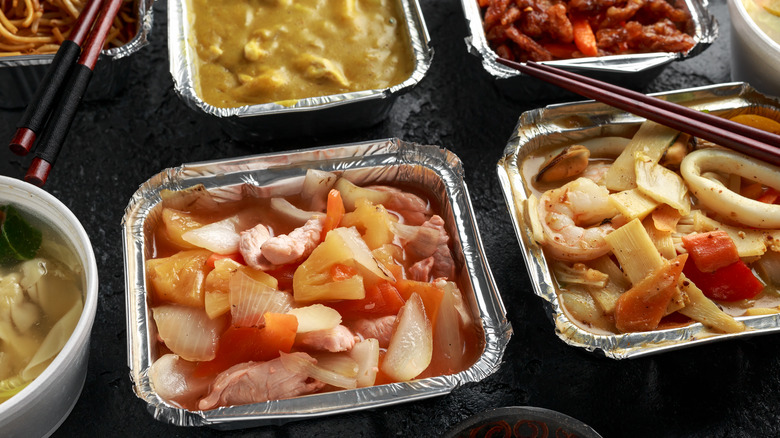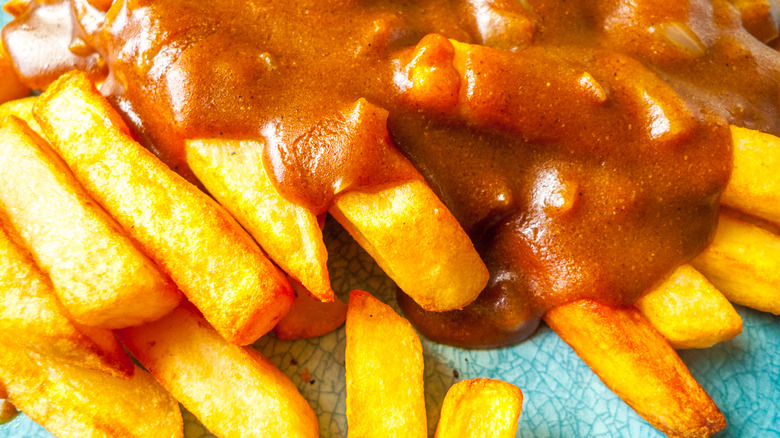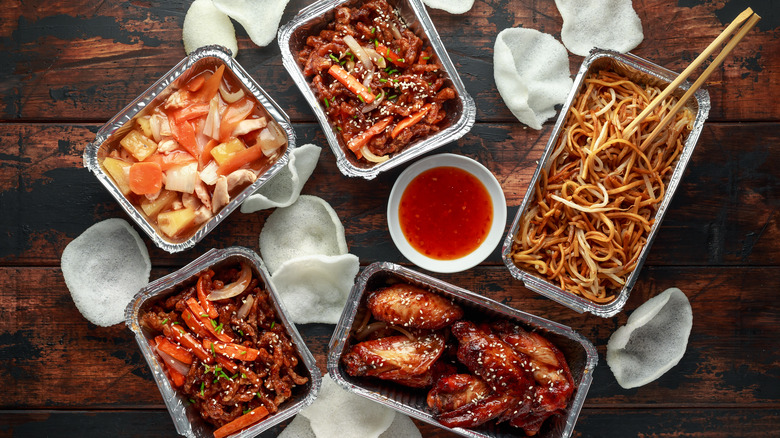British Chinese Food Would Probably Flabbergast Most Americans
As is typical these days, this food conversation began on TikTok. Users from the United Kingdom were innocently sharing photos of their grub when the Americans emerged, and thus began a clash to rival the Revolution. The metaphorical crates of tea? Chinese takeaway. The metaphorical Boston harbor? Dumbfounded TikTok duets, questioning the very core of the cuisine. The Americans said it was colorless. The Americans said it was entirely fried. The Americans wondered why there were fries served with every meal and what the sauce saturating every plate was.
The questions themselves weren't entirely without merit, even if they did take on the exaggerated nature of much internet discourse. It was just one of those British foods that Americans don't understand. From chicken balls with fried breading and chow mein noodles to fried rice and prawn crackers (what the U.K. gets instead of wontons), a lot of the food has a brownish hue. Equally, fries — or chips, as they're referred to across the pond — are served with many of the meals. And curry sauces of varying colors bathe most of the plates. For those unfamiliar with British Chinese takeaway, the sight was startling, and accusations of inauthenticity quickly joined the mix. But, as is the way of things online, it shouldn't be dismissed in that way, as the cuisine has a nuanced story.
Chinese food in Great Britain has a long history
The story of Chinese cuisine in the U.K. begins in the 1800s and has colonialism at its helm. British trading routes broadened to include Hong Kong and the New Territories (part of the Hong Kong Special Administrative Region), and the shipping expansion led to a number of men from Southern China being hired by English companies and migrating to U.K. port cities. In order to set up a life in their new home, these men started noodle shops for sailors and the Chinese diaspora.
After World War II, laws were changed and there was an influx of immigration, resulting in the number of Chinese restaurants in the U.K. doubling between 1957 and 1964. But many of these restaurants, takeaways in particular, were adaptable and strategic. They didn't just recreate dishes from their respective regions in China, they started fusing them with British staples to please British diners and reach a wider customer base.
If you examine the menus of British Chinese takeaways and British fish-and-chips shops, you'll probably find several similarities. Chips, curry sauce, chicken balls, and even sausages are pretty foundational — and that's no accident. Chinese immigrants who opened restaurants and takeaways leaned into the familiar and thus created a kind of fusion cuisine that endured and became one of the most popular in the U.K.
American Chinese food has a similar story
Although the unfamiliarity of the dishes to Americans may prove shocking, dismissing British Chinese takeaway as "inauthentic" is reductive. In fact, American Chinese food has a similar historical trajectory — the cuisine was sparked by immigration in the mid-1800s. As the food became more widespread, it began garnering backlash for its anomalous nature in the midst of accepted "American" foods. Over the years, dishes went through periods of Americanization, veering toward sweetness instead of spice to please local palates. This is why Chinese food tastes different in America.
It isn't a question of whether British fast food or American fast food is better. American Chinese food and British Chinese food are both the product of a need to survive and thrive in an unfamiliar place where the majority of locals wanted the familiar and rejected the "alien." Both cuisines are their own entities, versatile fusions of cultures that tell long and complex stories. Even if the flavors and aesthetics apparently don't speak to the online consumers in the States, British Chinese food is a principle piece of the United Kingdom's culinary landscape.


